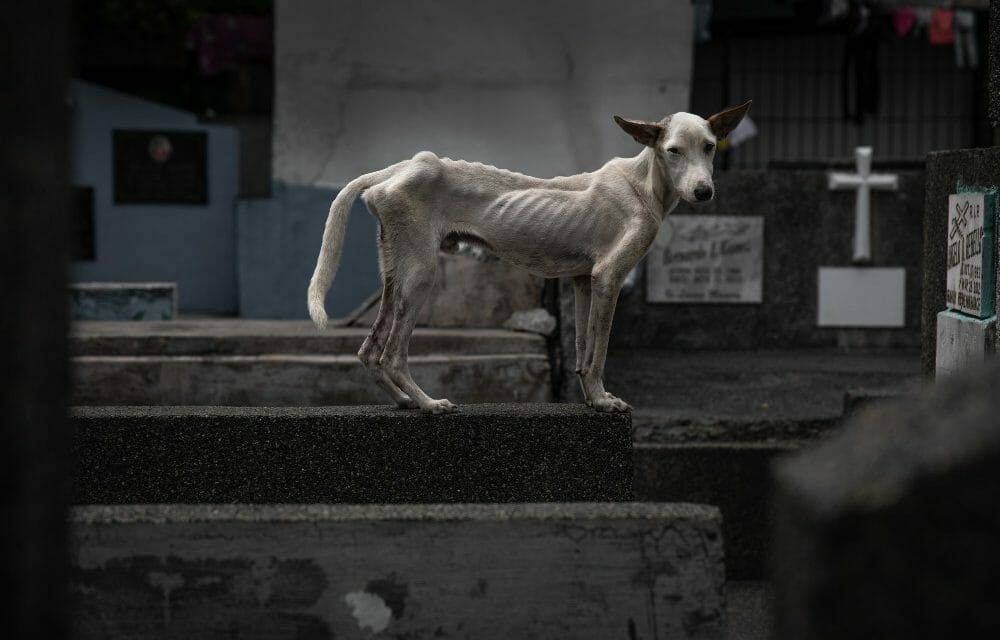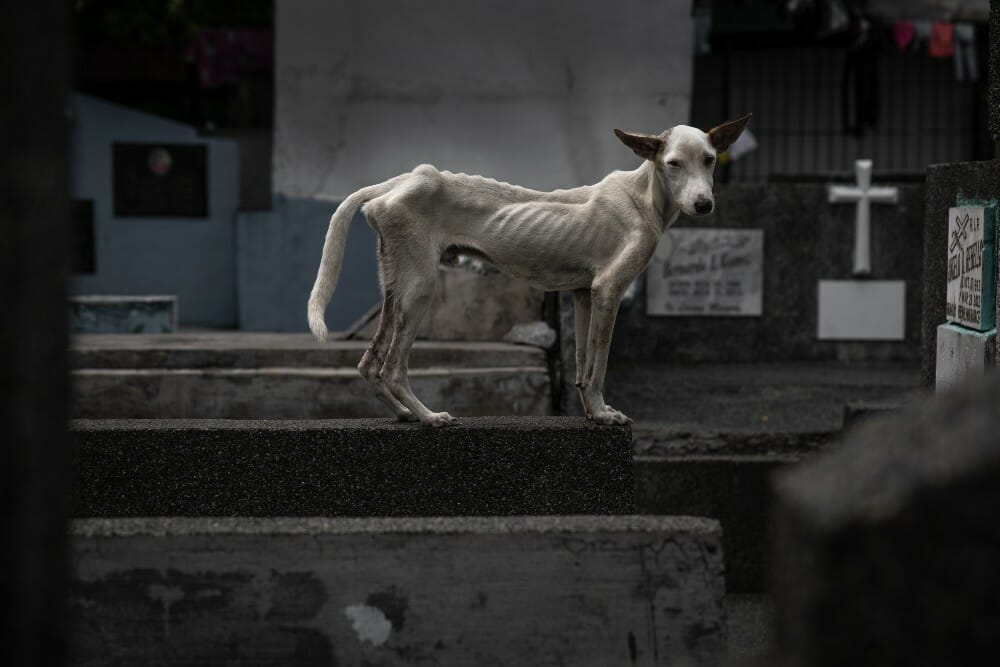His spiky vertebrae are sharply visible through his ghostly fur, his jutting ribs and pelvic bones matching the grisly monotone of gray cemetery aisles and a prominent white cross in the bleak background.
The wraith of a dog lives here, in a cemetery in Pasay, the Philippines, with the dead, but also with the living. He’s one of at least 400 animals — and 300 households filled with people — that call the crypts and graffiti-and-mold encrusted gravestones “home.”
The signs of the people are in plain sight: a tarp stretched over a slab, clothes drying on a line strung between grave sites, a child following another dog to one of the cemetery’s wells, where the residents draw their water.
There is no running water here. There is no sanitation service. There is scant electricity, pilfered from a public line and used to power TVs scattered through the mausoleums and a few computers, protected under another tarp, for children’s learning.
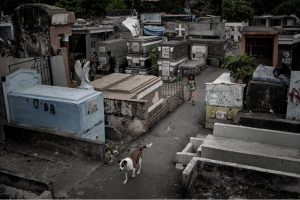
Photo Credit: Aaron Bertie Gekoski
Learning itself is rare, whether that is the skills the children will need to survive outside the cemetery’s walls or the proper way to care for the dogs and cats which are not the strays they seem to be.
Some animals sport raggedy collars. Others wear chains. Some are seemingly healthy, while others scratch themselves hairless to get at the sarcoptic mange scouring their bodies.
But both people and their pets have benefited from the humanitarian and public education efforts of nonprofit Pasay Pups and its founder, Ashley Fruno, who recently introduced internationally acclaimed environmental photojournalist Aaron Gekoski to the cemetery’s residents.
Stunning photography by Gekoski, commissioned by Lady Freethinker, reveals the extreme poverty and inspiring resolve of the 400-500 cats and dogs and at least 300 households of people living amidst the mausoleums and crypts.
Pasay Pups Helps People and Their Pets in the Philippines
For more than a decade, Fruno and volunteers have visited the cemetery on Saturdays, bringing hygiene and educational items for the children and food and medicine for the animals. Fruno estimated between 400 and 500 animals currently call the cemetery home, as do at least 300 households totaling between 700 and 800 people.
When the COVID-19 pandemic and regional lockdowns temporarily shuttered those activities, Fruno knew she had to keep the plight of the cemetery’s residents in the public eye.
She teamed up with award-winning photographer Aaron Bertie Gekoski, whom she introduced to the cemetery’s residents.
“Aaron was very respectful,” she said. “It was all done very openly, and very tastefully, and with people’s full permission. He even printed out some of his photos and gave them back to the people, which they loved.”
Gekoski’s photographs of the Pasay Municipal and Manila South cemeteries in Pasay, on display for the first time, highlight the heart-breaking poverty of the cemetery’s residents and the seemingly insurmountable challenges they face. Children, their clothes and faces streaked with dirt, walk the narrow cemetery aisles, pull water from the wells in small buckets, or stand beside emaciated forms of animals hunched in the graveyard pathways.
But as an artist viscerally against “poverty porn” — a term coined in the 1980s for media that exploits the poor’s condition to generate sympathy and charitable donations — Gekoski got to know the people. He got to know their pets.
And so there also are pictures of bright smiles from children sitting comfortably on tomb slabs, evening basketball and billiards games, and newly educated residents carrying their beloved pets back from a Pasay Pup’s spaying and neutering clinic.
“As a photographer, I want to tell the story that I witness,” Gekoski told Lady Freethinker. “What I saw there was not despair, but a tight-knit community. These people face incredible hardships that most of us could never even begin to imagine, and there is hope.”
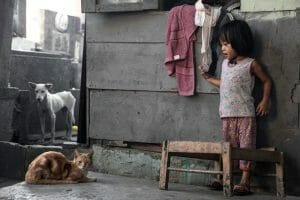
Photo Credit: Aaron Bertie Gekoski
Suffering Hidden In Plain Sight
Immigrants have flocked to the Philippines for more than a century, dreaming of better opportunities and livelihoods. Manila, the country’s capital, was the world’s most densely populated city proper in 2019.
Pasay, about eight kilometers (or five miles) south of Manila, has absorbed some of that influx. With more than 416,000 people packed within its seven square miles, the city is touted for its nightclubs along a picturesque waterfront, its national theater, and its mall with an IMAX cinema and skating rink. Travel guides market Pasay as a tourist destination of “thrills, culture, shopping, relaxation, and fun.”
Yet less than three miles away is the Pasay public cemetery, where children and families resort to pagpag — or eating from the trash — to survive.
Death is pervasive in Sarhento Mariano for both humans and animals — from remembrance markers and “R.I.P” messages blazoned on the crypt walls to the pet graves of two young kittens who died less than a year after their births.
The Philippines’ overall poverty and lack of affordable housing, employment opportunities, and resources for mental health and drug addiction contribute to people experiencing homelessness and their exodus to graveyard villages.
Some families have lived in the cemetery for generations, eking out livings by taking care of the tombs of wealthy families, engraving headstones, or selling flowers for gravesites — work that often brings in the equivalent of only $20 to $30 USD a year.
Others desperately want out but find themselves trapped by conditions at the cemetery — such as a lack of access to healthcare, education, or working toilets — which don’t give them an advantage when applying for jobs, Fruno said.
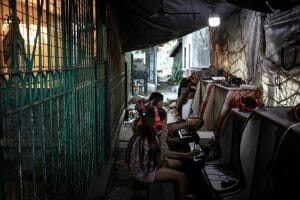
Photo Credit: Aaron Bertie Gekoski
A Different Culture and the Start of Something Bigger
Fruno originally arrived in the Philippines 14 years ago as a senior campaigner for People For The Ethical Treatment of Animals (PETA) — work that she continues to this day.
Outside a bus station one afternoon, Fruno ran into a stray pup she named Manny, who stole her heart and remained a steadfast companion on her jaunts around the city until he was tragically hit and killed by a bus. Fruno’s love for Manny catapulted her into saving as many suffering stray dogs as she could. The dogs led her to the people, and the people led her, ultimately, to Gekoski.
The internationally acclaimed environmental photojournalist, who specializes in human-animal conflict and cruelty in the wildlife tourism industry, was in the Philippines. He could see the cemetery from a window in his 3-bedroom apartment overlooking the city. Yet he had no idea what was going on there until Fruno popped him a casual question: Did he want to come check out her work in the cemetery?
Gekoski, whose travels have taken him to some of the world’s most impoverished places, said what he witnessed in Pasay was unlike anything he had experienced.
“I’ve never seen this anywhere in the world, where people are living in a cemetery, sleeping, watching TV, feeding their children on tombs. They’re unique places, where everyday life is deeply entwined with death,” he said.
Fruno agreed with that assessment.
“The cemetery is a very intense place,” she said. “There are a lot of smells, and people are everywhere. Some of our volunteers come once, and they never come back. Even the best fact sheet in the world can’t prepare you for this.”
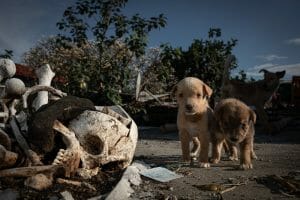
Photo Credit: Aaron Bertie Gekoski
One series of photographs that makes the cemetery’s reality clear is that of two tiny puppies, curiously approaching what appears to be a pile of human bones.
They are, Gekoski said. Cemetery plots in Pasay lease for about five years, and if families can’t continue to pay — or if they can’t pay in the first place — the bodies get exhumed, or the bones are left in trash bags on site.
There’s also a different understanding of animal welfare in the Phillipines that stems — not from inherent cruelty– but from a lack of awareness, both Fruno and Gekoski said. Fruno emphasized that her nonprofit approaches the cultural differences with the stance that education is key.
“Animal rights is a new concept in the Philippines,” she said. “We try to approach from a place of non-judgment. People are living in a situation that we can’t even comprehend, so we focus on the positives.”
Even the concept of proper veterinary care was a reach, with most cemetery residents not having access to basic services, such as parasite control, wound and skin treatments, or flea and tick prevention.
But Fruno absolutely believes there is room for hope — both for the residents, and for their furry friends.
A Community’s Resilience and a Canadian’s Resolve
Prior to the COVID-19 pandemic, Fruno and an assortment of about 20 volunteers hit the cemetery paths every Saturday, saying hello to the residents, checking in on dogs and cats, and working with the families’ children.
“We don’t feed the dogs daily, because we don’t want them to become totally reliant on us in case something would happen, like if all our volunteers would have to leave the country,” Fruno said.
During a single Saturday outing, volunteers would easily go through about 80 kilos — or 176 pounds — of dry dog food and 50 cans of wet food, Fruno said. They aimed to lead by example, taking dogs for walks on leashes, refilling empty bowls with water, and providing the animals with treats and toys.
Trained clinic workers treated dogs who had stepped on glass, dogs who had been stabbed by someone drinking, and dogs suffering from giardia and Ehrlichia — a parasite and a bacterium that can cause a host of problems if ignored.
“We don’t have the resources to take every animal to the vet, because the cost of veterinary care in the Philippines is very high, and there isn’t access to specialized services here,” Fruno said. “But we see the same things over and over, and most of it we can treat.”
Pasay Pups also hosted spay and neuter clinics, with surgeons in brightly colored scrubs calmly sterilizing animals beside bowls of bloody organs in the open air.
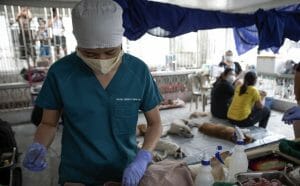
Photo Credit: Aaron Gekoski
The nonprofit estimates it served more than 100 animals each week, while vaccinating more than a thousand every year. The approach was working, Fruno said.
Pochie, one of the first dogs Fruno met in the cemetery, had such severely advanced sarcoptic mange that most of her body was hairless. The dog also was emaciated, spending more of her time scratching than eating. People in the cemetery were afraid to touch her. But once Pasay Pups hooked Pochie up with treatment, she gained back weight — and fur — and became a beloved member of the community.
Laela and her dog Ating are another success story. Ating had a vaginal tumor and was covered in mange when Fruno first met her, yet Laela allowed the dog to cuddle her and sleep by her side. Pasay Pups treated both of Ating’s conditions, and she’s now spayed and with a full coat of hair.
“They are always together,” Fruno said.
Gekoski’s photographs show the bond some residents have with their animals. In one, a person cuddles a large striped cat, their shadowed forms juxtaposed near another large cross and a portrait of Jesus prominent in the foreground. Residents also seemed friendly to each other and to him, Gekoski added.
“The cemeteries didn’t feel dangerous or unsafe,” he said. “Filipinos are lovely, happy, resilient people who have faced many challenges, yet always come out smiling. Visitors are made to feel welcome in the cemeteries, which feel more embracive than the business districts that overlook them.”
Challenges Continue, Hope remains
Fruno also has success stories of the people she’s met there. She related the story of a woman she called “Jane,” to protect her privacy.
While Jane had been working as a nurse, both she and her husband were addicted to Shabu, the local term for methamphetamine, Fruno said. Their addiction landed them, along with their four children, in the cemetery. An argument with a neighbor got the family thrown out of their mausoleum. They then lived near an underpass until Fruno tracked them down and found Jane sick and pregnant with another child.
Distraught and sure she was going to die, Jane asked Fruno to take her children to social services. Fruno found a Christian home nearby that agreed to take Jane and her children. Fruno returned in a few weeks to check in only to find the family was gone.
Six months later, however, she received a Facebook message from Jane, who had reached out to her family for help and had moved to her family’s farm.
“She said she was sorry for being out of touch,” Fruno relayed. “She wrote that she wanted me to know that things were going well, that she had kept her promise that she wouldn’t stay in that lifestyle. It made me realize how something really small can make a real difference.”
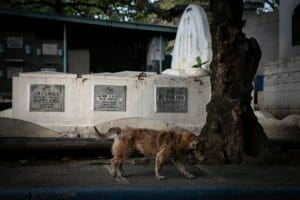
Photo Credit: Aaron Bertie Gekoski
The COVID-19 pandemic created new hardships, particularly in the first months following March 2020 when Pasay instituted a GCQ, or general community quarantine — a strict lockdown.
People weren’t allowed to leave the cemetery, Fruno said. They had little access, if any, to food. They also couldn’t engage in kalakal, or scavenging materials for scrapyards, and the scraps of income from that practice, she added.
Pasay Pups shifted to humanitarian aid, taking down rice, soap, and reusable masks twice a month despite volunteer numbers dropping down to a handful.
“It was shocking to us how few resources were provided to help get them through the lockdown,” Fruno said. “I also understand why we don’t have as many volunteers, now, but the show must go on.”
Both Gekoski and Fruno hope their partnership will raise awareness — and resources — for the people and pets of Pasay Cemetery.
“Photography is one of the most powerful storytelling tools we have,” Gekoski said. “All over the world, there are communities in need of support. The people and their pets living in Manila’s cemeteries might be warm and hospitable, but they don’t choose to live here. It’s their only option. And they’re in dire need of help.”
Fruno said she has plans to continue the fight for better animal welfare in Pasay.
“The Philippines is my home now,” she said. “I feel like I was meant to be here.”
RESOURCES
To support Pasay Pups financially in their mission to create a better world for Pasay’s dogs, cats, and children living in the cemetery, visit https://www.pasaypups.org/donate.
The organization also is always on the lookout for on-the-ground volunteers, Fruno said. For more information, those interested can check out Pasay Pups on Facebook or Instagram or visit https://www.pasaypups.org/get_involved.

